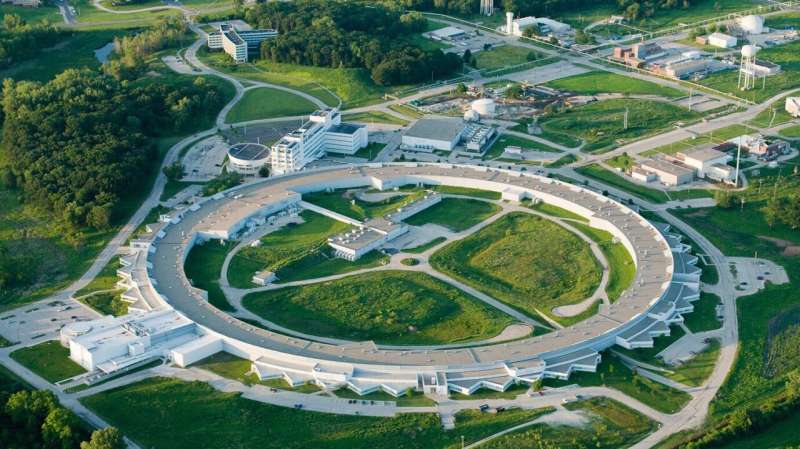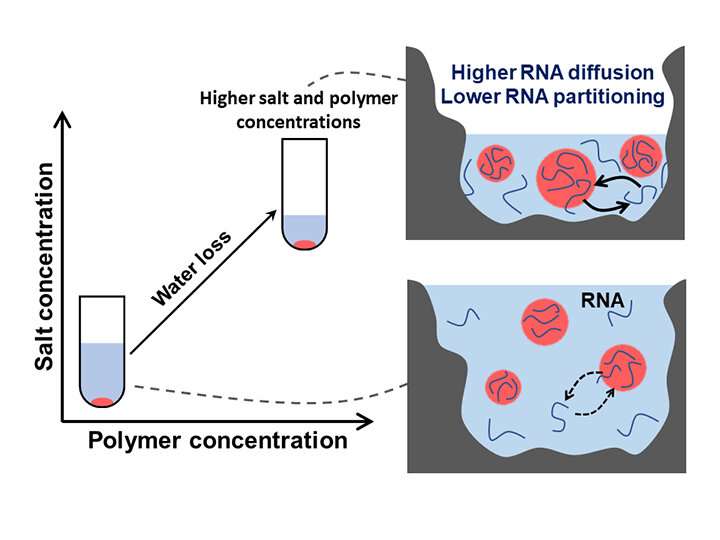Study shows how tiny compartments could have preceded cells

One of the most important questions in science is how life began on Earth.
One theory is that wet-dry cycling on the early Earth—whether through rainy/dry periods, or through phenomena such as geysers—encouraged molecular complexity. The hydration/rehydration cycle is thought to have created conditions that allowed membraneless compartments called complex coacervates to act as homes for chemicals to combine to create life.
Using the Advanced Photon Source at Argonne National Laboratory, scientists in the Pritzker School of Molecular Engineering (PME) at the University of Chicago studied these polymer compartments as they undergo phase changes to understand just what happens inside them during wet-dry cycle.
The results, published October 27 in Nature Communications, could not only shed further light on prebiotic Earth, they could also have implications for the design of electronics and drug delivery systems.
"Seeing these polymer assemblies as they undergo changes in complex environments helps us understand just how these compartments behaved on early Earth, and how we can use them going forward," said Matthew Tirrell, dean of the Pritzker School of Molecular Engineering, the Robert A. Millikan Distinguished Service Professor, and co-author of the paper.

Seeing inside complex coacervates
In research led by Pennsylvania State University, scientists examined polyelectrolyte coacervates in water that had the same makeup as pond water. A pond regularly dries up and is then replenished with rain. This cyclic dehydration and rehydration makes it easier for molecular building blocks, like amino acids and nucleotides, to assemble into peptides and proteins, like DNA and RNA, by lowering the thermodynamic barrier that keeps them from combining.
The Tirrell Lab are experts on polymer compartments like polyelectrolyte coacervates, having previously described how these materials act under different phase changes.
The PME researchers used small-angle X-ray scattering at Argonne's Advanced Photon Source to look at the internal structure of coacervates as the wet-dry conditions changed. They found that as the water sample dried, the concentration of RNA increased, but the RNA concentration inside the polymer compartments remained constant. They also found that the salt concentration of the sample increased as the water dried, weakening polymer interactions, which made the compartments actually more hydrated.
Repetitive cycles of hydration and dehydration "caused a progressive evolution of the compartments," Tirrell said, which permanently changed the composition of the coacervates.
"This changes the physical properties of the coacervate and affects molecule exchange, which could be a clue for how early life began," said Alexander Marras, a postdoctoral researcher in Tirrell's group.

Designing drug delivery systems
Understanding how dynamic conditions affect coacervates could have implications in electronic devices that use the polymer compartments in visual displays, or in drug delivery. Compartments like this could be used to carry a therapy within the body, and understanding how polymers assemble and react to changing conditions is key to designing new ways to deliver drugs.
Marras, former UChicago postdoc Jeffrey Ting, and researchers with Penn State forged this research collaboration during a Gordon Research Conference in Switzerland. Penn State researchers, who ultimately led this research, were interested in studying how coacervates behaved on the early Earth. During a hike on a glacier, Ting, Marras, and the Penn State researchers discussed how they could collaborate by using the Advanced Photon Source to see inside the compartments.
"Argonne is really a world-class facility that allows us to be at the forefront of this kind of work," Marras said.
More information: Hadi M. Fares et al, Impact of wet-dry cycling on the phase behavior and compartmentalization properties of complex coacervates, Nature Communications (2020). DOI: 10.1038/s41467-020-19184-z
Journal information: Nature Communications
Provided by University of Chicago





















